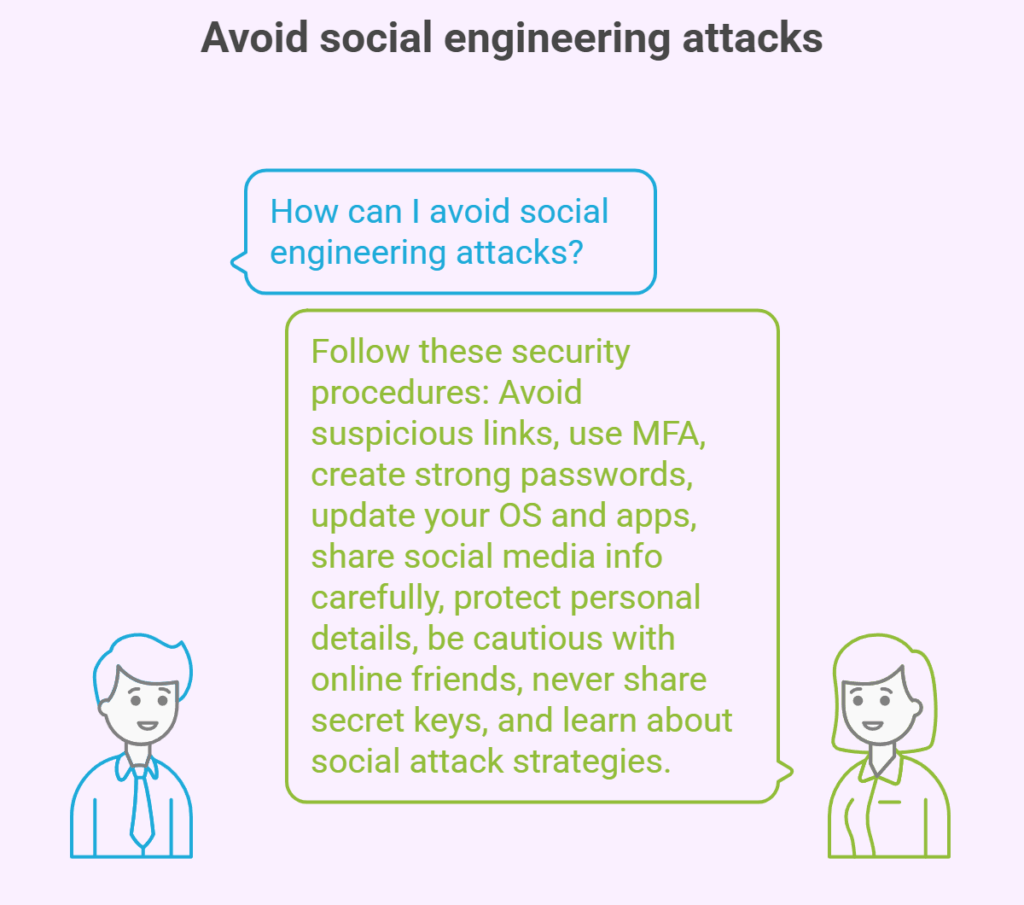Social engineering attacks pose a serious risk in the digital world, especially in the expanding cryptocurrency, NFT, and Web3 industries where con artists are always coming up with new ways to take advantage of people’s trust and gullibility. These attacks degrade security by taking advantage of human psychology as opposed to technological flaws. We are talking about attacks using social engineering. What are the types of social engineering attacks, how do they operate, why do they work, and why are cryptocurrency users the targets of these attacks?, Who Are the Main Targets of Social Engineering Attacks? How Can I Recognize the Most Common Social Engineering Attack Types? This blog discusses how to avoid social engineering Attacks.
What is a Social Engineering Attack?

The practice of tricking people into disclosing information or acting in ways that jeopardise the security and privacy of bitcoin networks is known as social engineering. It mostly entails taking advantage of people’s gullibility, trust, and desire to believe what they are told. Since legitimate user errors are less common and more difficult to identify than malware-based attacks, social engineering can be more challenging to protect against and avoid than attacks that target software or system weaknesses.
Also Read About How Oracle Manipulation Attacks Works: Understanding Threat
These attacks target the human factor involved in using blockchain technology rather than simply exploiting technological flaws in the blockchain itself.
How Social Engineering Attacks Work?
Attacks using social engineering are surprisingly easy to carry out. A hacker only needs to persuade a gullible, hurried, or trusting person to do what they say.
It typically consist of two fundamental stages:
Investigation
To obtain crucial background information, including possible entry points and weak security protocols, the attacker first looks into their target. They get ready for the attack this way.
Manipulation
After acquiring confidence, they offer incentives for unsafe behaviors like sharing vital resources or confidential information.
The procedure frequently follows this pattern:
- Getting ready and looking at targets that possess the desired item for the attackers.
- Infiltrating by establishing a rapport based on mutual trust.
- As soon as trust is established, attacking the victim.
- Pulling back once the user has completed the intended activity.
This could be as straightforward as an email exchange or a lengthy string of social media discussions that eventually result in the victim disclosing personal information or opening themselves up to harmful software. In one well-known instance, hackers tricked Twitter staff into granting them access to private procedures, which they then utilized to take over well-known accounts (such as those of Joe Biden, Elon Musk, Bill Gates, and Kanye West) and deceive followers into sending Bitcoin money straight to them.
Social engineering can also involve:
- Posing as someone in a position of power.
- Inflating the sense of urgency.
- Presenting incentives.
- Disseminating false information via social media.
Also Read About Sybil Attack Detection In Blockchain & Sybil Attack History
Types of Social Engineering Attacks
A number of typical social engineering attack types are noted:
Phishing Attack
Phishing attacks are fraudulent emails or texts that are disguised to appear as official correspondence from respectable businesses. By appearing trustworthy, the sender is trying to get credit card data or passwords from the recipient.
- Sending bulk emails or communications to as many individuals as possible in the hopes that some may fall for it is known as spam phishing.
- Spear Phishing: Hackers build personalized communications after researching potential victims. These often target CEOs and celebrities. Phishing attacks rose 170% in Q2 2022.
Baiting Attacks
These attacks use the promise of a freebie to pique victims’ interest. In order to install malicious software, attackers may leave infected CDs or USBs in public areas, hoping that someone will pick them up and insert them into their computers. Email attachments containing “free offers” or alleged “free” software should be avoided.
Quid Pro Quo
A sort of baiting attack in which criminals provide their victims with something of value in return for private information. This expression is Latin meaning “Something for Something.” Providing a password and email address to a hacker to fix a computer may reveal personal information. The promise of a worthwhile return with little work may deceive victims and result in data theft.
Scareware
Scareware is a type of malicious software that creates fictitious alerts and notifications. It frequently shows popups or security warnings that indicate the computer is afflicted with malware. A “virus removal program” is then requested to be downloaded by the victim. After being downloaded, this “tool” is actually malware, which gives the hacker access to personal information or tricked the victim into buying fake cybersecurity software or disclosing login credentials.
Pretexting
This frequent tactic entails fabricating a situation or “pretext” in order to persuade someone to divulge private information. To be trusted, the attacker must be very active. An attacker could phone a bank, impersonate an employee, and request passwords or other sensitive data. These calls may be tougher to identify than phishing emails.
Impersonation
To obtain user accounts or information, attackers may pretend to be developers, customer service agents, or other reliable individuals.
Fake Giveaways and Scams
These entail fabricating campaigns or providing “free” bitcoin in an attempt to trick consumers into divulging their private keys or donating their own money.
Rugged Pulls
When cryptocurrency project insiders fabricate excitement, they subsequently abandon the project and steal investor money.
Also Read About How To Prevent Sybil Attack In Blockchain Strategies Guide
Why Social Attacks Are Effective and Why Crypto Users are Targets?
Social attacks are successful for a number of reasons, mostly because of human behavioural flaws and the particulars of the crypto industry:
- Human error: Since people are frequently the weakest component of security systems, they can be tricked and manipulated.
- Lack of Awareness: A lot of users don’t know how to spot social attacks or the dangers they pose.
- Trust in Social Media: Social media sites are ideal for launching social attacks and disseminating false information.
- Blockchain-based irreversible transactions: On most blockchains, a transaction cannot be undone once it has been approved. Without a “chargeback” or centralised authority to appeal to, a single erroneous click can result in a permanent loss of funds.
- The Decentralised Nature of Blockchain: Because blockchain technology is decentralised, there is no central authority that can freeze or retrieve stolen assets. Scammers take advantage of this since they know that once money leaves victims’ pockets, they are on their own.
- High Stakes & Greed: Many users are drawn to cryptocurrency by the possibility of quick, significant gains. By offering exclusive bargains or “insider” possibilities, social engineers take advantage of greed and FOMO (fear of missing out), making it simple to ignore warning signs in the pursuit of rapid financial gain.
- Knowledge Gaps: Many novices are ignorant of fundamental security concepts including phishing URLs, seed phrases, and the significance of two-factor authentication. This ignorance is a prime target for scammers.
Who Are Social Engineering Attacks’ Primary Targets?
Attacks using social engineering target a variety of victims:
- Individuals: This category comprises well-known businesspeople, famous people, and anybody else who has access to classified material.
- Businesses and Organizations: Particularly those with lax security measures.
- Government services and agencies may be abused.
- Entry-level personnel and younger generations: Their cybersecurity inexperience may make them more vulnerable. Businesses should be careful when training these workers.
Also Read About Benefits Of Bitcoin, Disadvantages And Characteristics
How to Identify Most Types of Social Engineering Attacks?
Alertness and attention are needed to recognize social engineering attacks:
Explore Unknown Senders
If you receive a message from someone you don’t know, check their email or social media. Find characters who resemble people (“torn@example.com” instead of “tom@example.com”) or bogus social media profiles that imitate pals.
Verify sender identity
Call or meet a questionable sender, even a friend or coworker. Their account may have been hacked.
Check Website Details: Visit unfamiliar websites and check the business logos, image quality, and URL (especially HTTP vs. HTTPS).
Mistakes or outdated content indicate a bogus website. Immediately leave if suspicious.
The “Too Good to Be True” question presents
Offers or incentives that look too good to be true might raise suspicions. These frequently serve as calculated enticements for social engineering scams. Ask yourself why someone would provide something of value if there was no clear advantage to them. Your email address is only one example of the basic data that can be gathered and sold to dishonest advertisers.
Watch Out for Odd Links or Files
If an email has a link or file name that seems strange, you should be wary of the entire exchange. Check for other warning flags like odd timing or context. Avoid clicking dodgy links or attachments.
Skeptical
Be careful of unsolicited emails, texts, and offers, especially if they appear too good to be true.
Confirm Information
Confirm the accuracy of communications and websites by independently confirming the information via official means.
Avoid social engineering attacks

Consistent security procedures and knowledge are necessary to stop social engineering attacks:
- Avoid Suspicious Links: Avoid clicking on links from recognized or unknown sources in suspicious emails or messages.
- Turn on MFA when available for enhanced security.
- Be Strong: Use a password manager to create unique passwords for each account.
- Update OS and apps regularly for security.
- Share Social Media Information Carefully: Public platforms and social media can misuse information.
- Don’t reveal your birthplace, pets, or school names.
- Be careful when making internet pals after meeting someone.
- Never share secret keys: Even if someone pretends to be from a respected company, never give them your passwords.
- Learn social attack strategies and how to identify them.
Also Read About Meaning of MetaMask, Advantages, Functionality & Purpose
Report questionable Activity: Notify the appropriate platform or authorities of any questionable activity you come across.
Organizations and individuals can greatly defend themselves against the negative impacts of social engineering schemes by putting in place robust security rules, keeping an eye on questionable conduct, and educating staff members and individuals.
